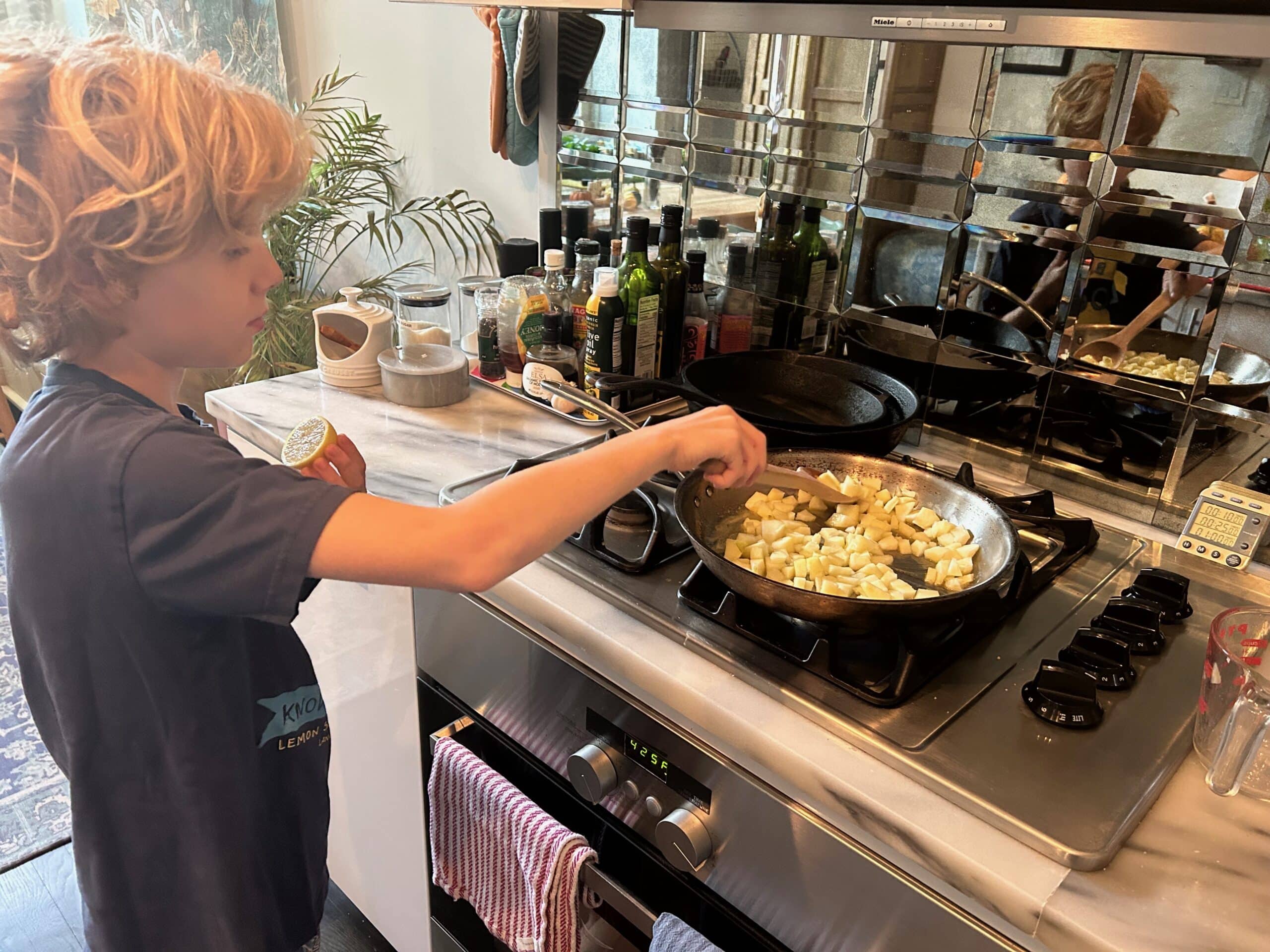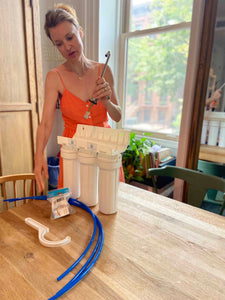Types of Toxic & Non-Toxic Cookware
Pots and pans come in a wide range of materials. Some cookware materials are okay, if you have the right variety, or if you don’t use them every day. Let’s go through these one by one, including the brands we recommend.
Nontoxic Cookware Materials
The following materials are always non-toxic. We will share our favorite brands made of these materials below, under The Best Stuff.
Carbon Steel
Carbon steel is sometimes used for frying pans and woks. It’s similar to cast iron, and can leach small amounts of iron into food, which is great if you have someone with slight anemia in your home!
Cast Iron
For most of human history, people suffered from iron deficiencies, so cooking with cast iron helped to prevent anemia. In modern cultures, the opposite is true. Most of us get plenty of iron, and there’s a point at which ingesting too much can be problematic. In our kitchen, we try to switch between cast iron pans and pans made of other materials throughout the week. If you want to be extra cautious, you could avoid cast iron for recipes with long cooking duration or acidic foods, as this will cause increased iron leaching.
Stainless Steel
Stainless steel pans are generally Good Stuff. The only caveat here is that stainless steel is made with nickel (the more nickel in the mix, the more “stainless” it is). The problem is that our bodies can handle some nickel, but too much isn’t healthy. This means that high quality stainless steel cookware, which has higher percentages of nickel, is actually of more concern than lower quality stainless steel! We know that stainless steel pans do leach nickel (along with some chromium and iron), especially with longer cooking times and when cooking acidic foods such as tomatoes. To minimize the potential for nickel leaching, you’d ideally want a pan that’s 18/4 or 18/0 stainless steel (that first number is the percentage of chromium; the second is nickel). I wouldn’t be concerned about using stainless steel as long as you just switch up your cookware. If you sometimes using cast iron and enamel pots and pans, you won’t be exposing yourself to too much nickel from stainless steel. If you’re still worried, you could avoid stainless steel when cooking acidic foods for long time periods.
Tempered Glass
Glass is probably the most inert of any cooking surface, and you can even get pots and pans made of this ultimate Good Stuff!
Titanium
Titanium is a non-toxic and biocompatible metal, so it is used for medical instruments, dental implant devices, and joint replacements. Titanium is also lightweight and extremely strong. Titanium cookware uses an aluminum base for even heat transfer and distribution. The non-porous, non-stick titanium outer surface does not allow any aluminum to leach through. The only reason to be cautious about titanium cookware is that it seems that most manufacturers now coat their titanium cookware with non-stick finishes, rendering it “Bad Stuff.”
Materials That May Be Safe in Cookware
When shopping for non-toxic cookware, some of these materials come in safe forms. Other times, they are treated (or untreated, as the case may be) in a way that renders them less safe.
Clay
Without testing a clay pot for every possible contaminant, you have no way of knowing what might be leaching into your food. Without a glaze on the pot, there is no protective barrier between what’s in the clay and your meal. The risks of unglazed clay pots and pans outweigh the potential benefits of the good minerals that might leach into your food—calcium, iron, etc.
Coated Ceramic
Made from natural materials such as clay and minerals, ceramic cookware offers excellent heat retention and distribution. Its non-reactive surface makes it ideal for cooking acidic foods, and it is also appreciated for its nontoxic nonstick cookware properties, requiring less oil or fat during cooking. Furthermore, it is generally considered safer than nonstick alternatives since it doesn’t contain potentially harmful chemicals like PFOA or PTFE. Ceramic cookware can be considered a safe less-stick if not truly truly non-stick material. Some ceramic cookware is coated with materials that may contain harmful substances like lead, cadmium, and other heavy metals. To ensure safety, it is crucial to choose ceramic cookware that is labeled as free from toxic materials and is certified as being compliant with safety standards.
Enamel
In essence, enamel is a form of glass. Enameled cookware is most often cast iron with an enamel coating. This type of cookware is wonderful to cook with. Some people have worried about lead in the enamel cookware, since the enamel coating is often made of clay, which can leach lead. For this reason, we suggest choosing high quality enamel cookware from well-known brands.
Materials to Avoid in Cookware
The following materials are always unsafe when used for cookware. You’ll learn more about how to avoid them under the Bad Stuff and Sneaky Stuff, below. Look for cookware brands that they have tested under limits for California Prop 65 for more peace of mind.
- Aluminum
- Copper
- Nonstick/Teflon
- Plastic








































247 comments
Candy
What about “ceramic copper infused cookware” otherwise known as “Red Copper”? Thanks
Kyra (kEARuh)
Hi! I’m looking for cookware that’s on the “safer” side, preferably non-stick (that i’m finding is not particularly safe even if it’s “safe”). At this point, the research has got me completely bonkers. The metals, the toxins, the tests, the results, warnings, recommendations to this use this pan for that, that pan for this… It’s overwhelming. I’m no expert cook, I don’t think about possibly using using cast iron for one dish and stainless steel for another. I just want a decent home-cooked meal without thinking I’m poisoning myself because of the cookware I’m using or double poisoning myself because I burned "whatever "the other day in the cookware i’m using. I’ve spent three and a half decades of my life eating what was put before me without a thought of what it was cooked in, and seem to be just fine, so I’m not sure why it matters, but it does! For whatever reason it does. I don’t own a microwave or use aluminum foil if I don’t have to and I don’t even remember why, haha… Ugh, I’m cookware babbling. In a nutshell, I’ve narrowed it down to two brands/three types. Le Creuset: toughened non-stick, and two GreenPan: Padova ceramic non-stick OR Paris Pro anodized aluminum ceramic. I did read about GreenPan and the use of silicone, but other articles have said it’s silicon, sans the e, and that there’s a difference. More to overwhelm me, sigh. But I must forge on! There’s mediocre pastas and soups and breakfast dishes to be made! Any words of wisdom/advice on the three I’ve listed? And knowledge regarding silicone vs. silicon?
Thanks for taking the time to read this.
Suzanne Weaver-Goss
Hi Joanna, We remain wary of any aluminum cookware. We don’t want to be alarmist. Having said that, almost every “non-stick” cooking surface that was once deemed “safe” has later been found to be concerning…at best.
Joanna
Do you know anything about circulon anodized cookware? It’s label non stick. Just want to make sure it’s bad before I ditch them.
Jackie
Hi, how can you determine if a ceramic coated or porcelain enamel pan is treated with a non stick chemical? I’ve seen many advertised at “Ceramic coating is naturally non stick which sounds like it hasn’t been treated with an added chemical but of course that can be misleading. Can you give any advice on how to determine this? Thanks!
Lesya
Hello,
I’m wondering if you ever heard of the brand The Rock by Heritage and what your thoughts are on that type of cookware.EL Mehdi
Thanks for sharing this guide. It’s very informative.
I was wondering, which cookware type would you recommend for a beginner to start with?
John Goss
Hi Audrey,
John here…
We are not fans of any cookware that claims “non-stick”. There are several new-ish technologies out there but we are yet to be convinced that they are totally non-toxic.
Audrey
Hi Maia,
I’m looking to get a deal on safe cookware and found a couple at Costco. I’m wondering if they’re actually as good as they advertise. Do you have any knowledge on these brands? Green Pan- ceramic nonstick, and stainless steel on the the outside Henckels- ceraforce ceramic nonstick, PTFE and PFOA free, and stainless steel tri-ply clad Thank you!Jessica
Hi Maia and John – Do you have thoughts on non-toxic cutting boards or plans to develop a guide? I’m having trouble finding anything that I feel confident isn’t filled with glue or, if it isn’t, would be safe for cutting meat. Thoughts? Thanks!